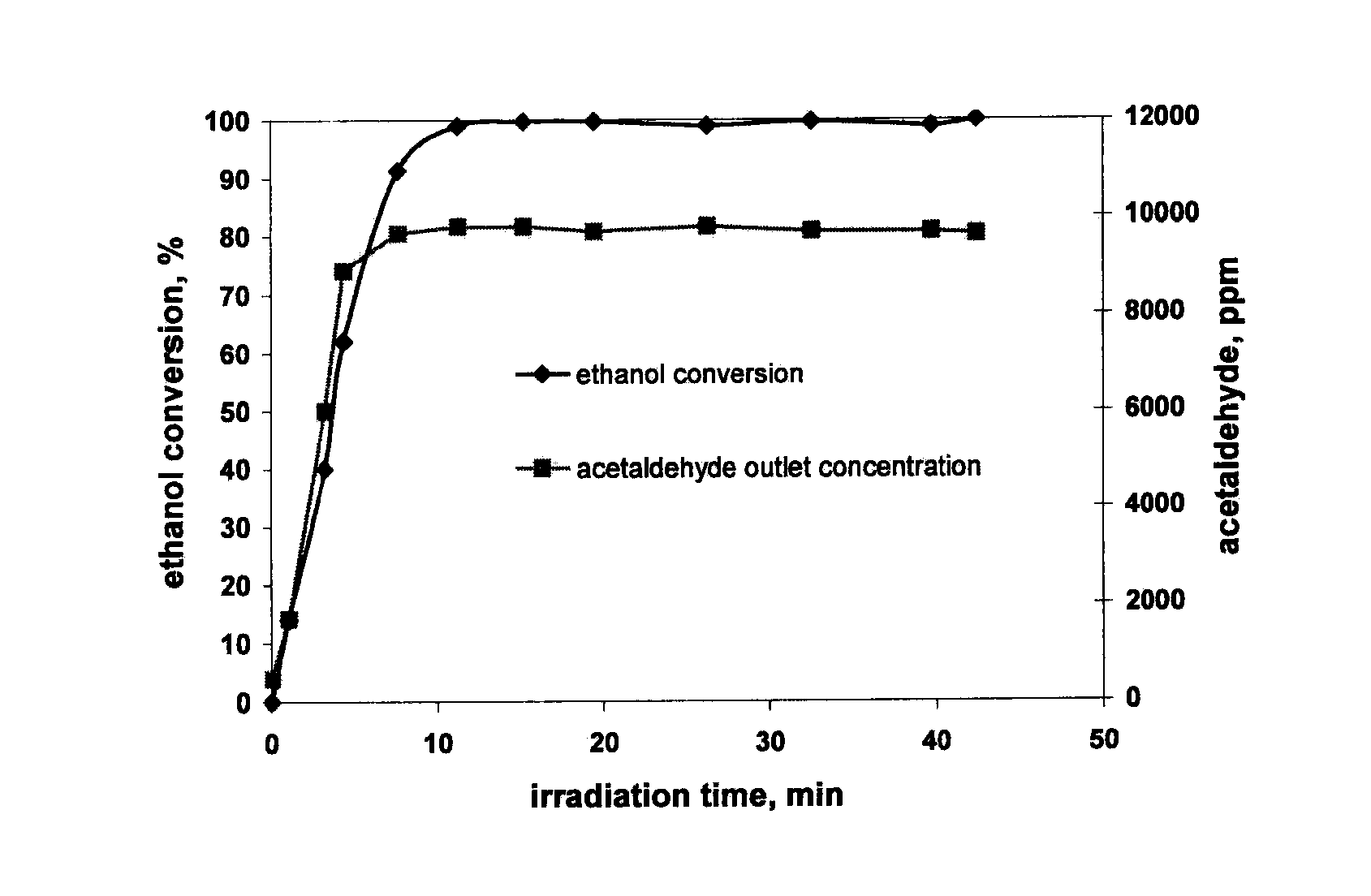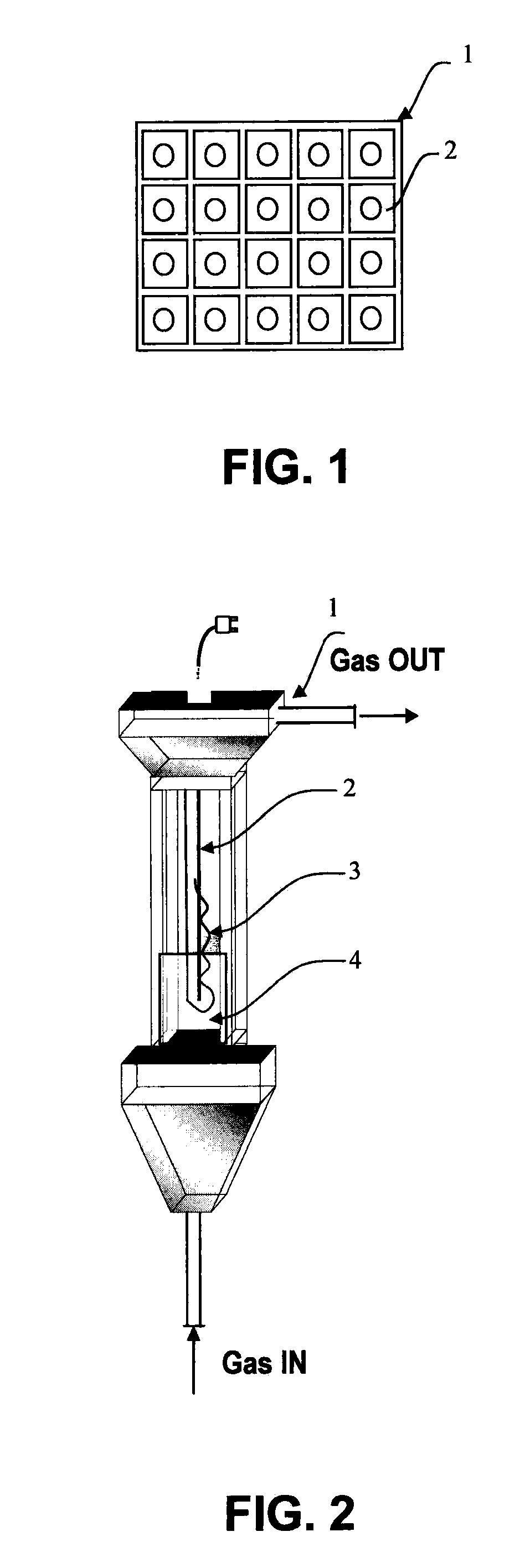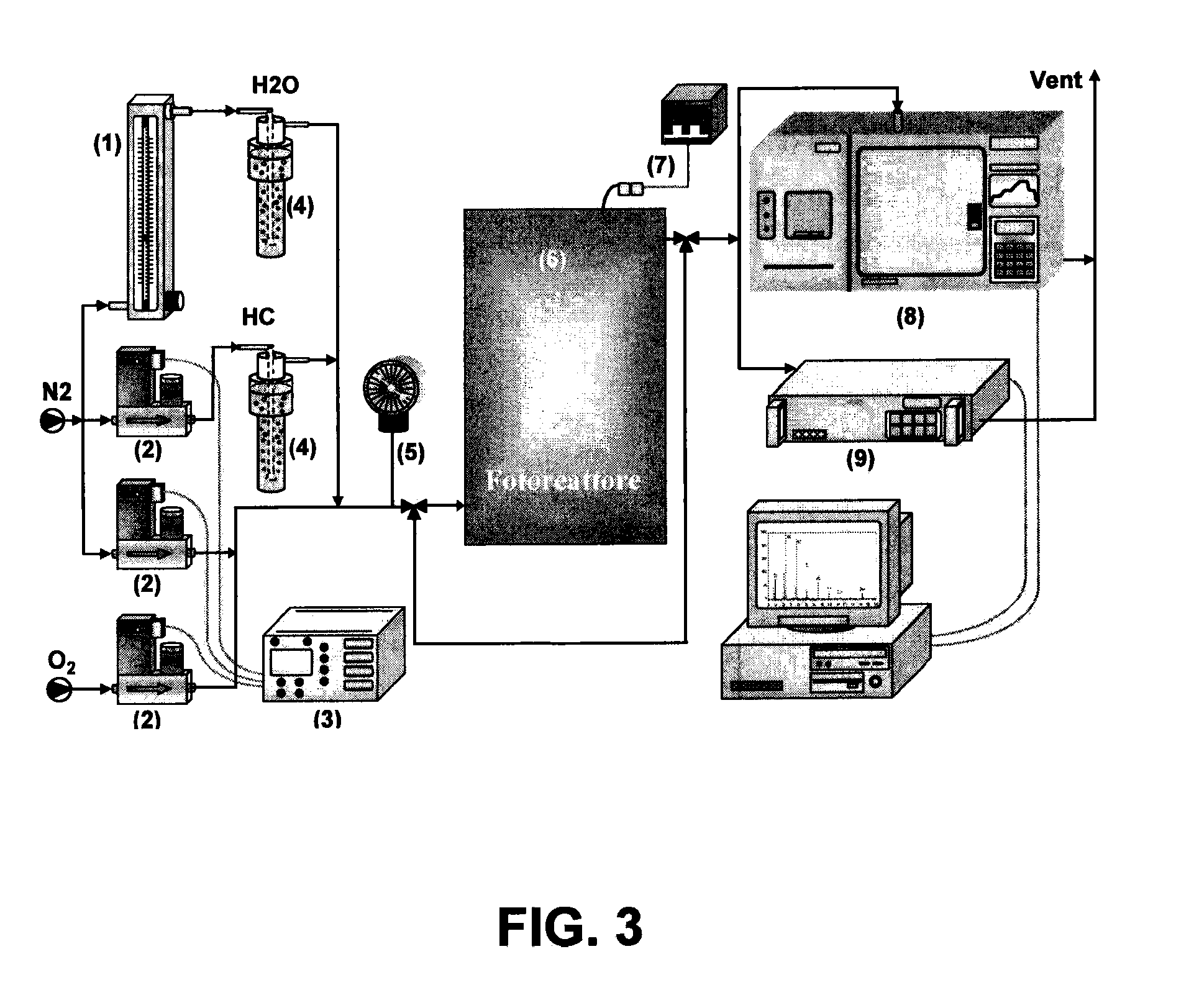Photocatalytic fluidized bed reactor with high illumination efficiency for photocatalytic oxidation processes
a photocatalytic and fluidized bed technology, applied in hydrocarbon preparation, lighting and heating apparatus, furnace types, etc., can solve the problems of no studies known at present regarding the use of two-dimensional photocatalytic fluidized, and no indications are known about the use of catalyst beds
- Summary
- Abstract
- Description
- Claims
- Application Information
AI Technical Summary
Benefits of technology
Problems solved by technology
Method used
Image
Examples
examples
[0054]Examples 1-4 show the results obtained for the measure of the photocatalytic activity on total oxidation and selective oxidation of hydrocarbons with evaluation of the illumination efficiency of the reactor in one exemplary case, employing both unsupported catalysts (TiO2) and sulphated V2O5 and MoO3-based catalysts supported on metal oxides (TiO2 and γ—Al2O3 and their mixed oxides).
Materials and Chemicals Used
[0055]Benzene with a purity grade equal to 99.9% was provided by Aldrich, toluene with a purity grade equal to 99.8% was provided by Aldrich, acetone with a purity grade equal to 99.8% was provided by Riedel de Haen, cyclohexane with a purity grade equal to 99.9% was provided by Aldrich and ethylbenzene with a purity grade equal to 99.9% was provided by Aldrich.
[0056]Ammonium heptamolybdate ((NH4)6 Mo7O24.4H2O) was provided by J. T. Baker, ammonium metavanadate (NH4VO3) was provided by Carlo Erba Reagenti, ammonium sulphate ((NH4)2SO4) was provided by Carlo Erba Reagenti...
example
Total Photocatalytic Oxidation of Benzene
[0058]Photocatalytic oxidation of benzene was carried out feeding 830 (stp) cm3 / min air containing 200 ppm of benzene in the presence of water vapour. Water / hydrocarbon ratio was equal to 1.5. The reaction temperature was 80° C. The reactor was loaded with 3 g of catalyst diluted with 6 g of α—Al2O3. The incident light intensity was 100 mW / cm2. Benzene conversion and CO2 outlet concentration on PC500, and on a catalyst containing 0.8 wt % of V2O5 nominal loading (0.8V) supported on PC500 as a function of irradiation time are reported in FIG. 4 and FIG. 5 respectively. CO2 was the only product detected in the gas phase (100% selectivity), reaching steady state values after about 30 minutes. On 0.8V catalyst, steady state benzene conversion was about 28%, higher than that one obtained on PC500 (9%). No apparent deactivation has been observed under the experimental conditions. The addition of vanadium determined an increase of photocatalytic act...
example 2
Oxidative Photocatalytic Dehydrogenation of Cyclohexane
[0059]In FIG. 6 the results obtained by loading 14 g of a catalyst containing 10 wt % of MoO3 nominal loading supported on TiO2—Al2O3 (10 MoPC100 Al) are reported. TiO2—Al2O3 mixed support was prepared by dispersing PC100 titania powder in a boehmite sol following the procedure reported in the detailed description of the invention. When the UV-LED modules were switched on, the cyclohexane outlet concentration immediately decreased reaching a steady state value corresponding to about 10% cyclohexane conversion after about 10 minutes. In the same figure the change of oxygen outlet concentration is also reported showing behaviour similar to that of cyclohexane.
[0060]The analysis of products in the outlet stream disclosed the presence of benzene and traces of cyclohexene, as identified from the characteristic fragments m / z=78, 77, 76, 74, 63, 52, 51, 50 (fragment 78 reported FIG. 6) and 82, 67, 54, respectively (fragment 67 reported...
PUM
| Property | Measurement | Unit |
|---|---|---|
| Temperature | aaaaa | aaaaa |
| Temperature | aaaaa | aaaaa |
| Fraction | aaaaa | aaaaa |
Abstract
Description
Claims
Application Information
 Login to View More
Login to View More - R&D
- Intellectual Property
- Life Sciences
- Materials
- Tech Scout
- Unparalleled Data Quality
- Higher Quality Content
- 60% Fewer Hallucinations
Browse by: Latest US Patents, China's latest patents, Technical Efficacy Thesaurus, Application Domain, Technology Topic, Popular Technical Reports.
© 2025 PatSnap. All rights reserved.Legal|Privacy policy|Modern Slavery Act Transparency Statement|Sitemap|About US| Contact US: help@patsnap.com



